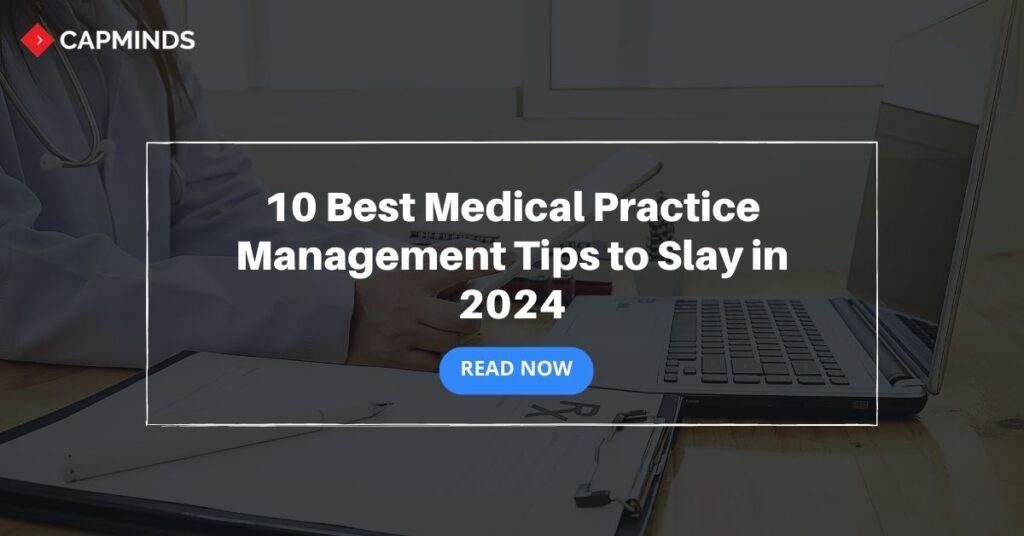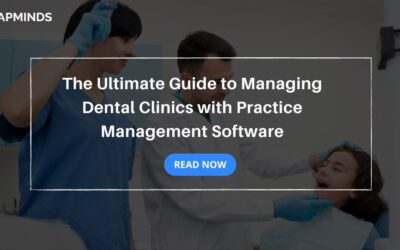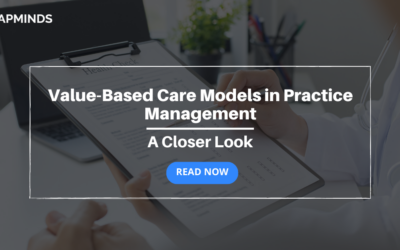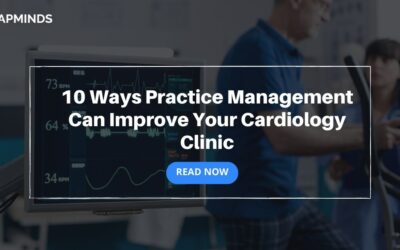10 Best Medical Practice Management Tips to Slay in 2024
In the vast and intricate world of healthcare, practitioners find themselves navigating through a labyrinth of regulations while juggling the task of managing precious patient data and ensuring the smooth flow of revenue cycles. It’s like a constant whirlwind, demanding adaptability at every turn.
To stand strong amidst this whirlwind, healthcare providers aren’t just aiming to survive; they’re striving to excel. They understand that triumphing in this intricate landscape requires more than just a reactive approach—it demands a comprehensive strategy, and a sturdy ship to weather these storms head-on.
This blog intricately explores the top 10 medical practice management tips for triumph in 2024. It doesn’t just offer theoretical ideas but rather furnishes actionable insights and pragmatic solutions, empowering medical practices to flourish in today’s fiercely competitive healthcare arena.
1. Embrace Technology for Streamlined Operations and Enhanced Patient Care
Technology has revolutionized the way healthcare is delivered, and medical practices can reap significant benefits by adopting the right tools. Practice management software can streamline scheduling, billing, and patient records, while telemedicine solutions expand access to care, particularly for patients in remote areas.
Challenges:
- Adopting new technologies can be costly and time-consuming.
- Training staff on new software can be challenging.
- Integrating new technologies with existing systems can be difficult.
Pain Points:
- Inefficient patient scheduling and registration
- Delayed patient care due to manual processes
- Lack of access to patient data across different systems
Resolutions:
- Choose a practice management software that is affordable and easy to use.
- Provide comprehensive training to all staff members on new technologies.
- Work with a technology consultant to integrate new systems seamlessly.
2. Optimize Scheduling for Efficient Patient Flow and Reduced Wait Times
A well-organized schedule is the cornerstone of efficient practice operations. Utilize scheduling software to optimize appointment times, minimize patient wait times, and avoid overbooking. Send appointment reminders, offer online scheduling options, and consider implementing same-day or walk-in appointments for urgent cases.
Challenges:
- Accurately predicting patient demand
- Balancing patient needs with provider availability
- Avoiding overbooking and scheduling conflicts
Pain Points:
- Long patient wait times
- Patient frustration with scheduling issues
- Lost revenue due to missed appointments
Resolutions:
- Implement dynamic scheduling algorithms that consider patient acuity and provider availability.
- Utilize patient self-scheduling portals to reduce administrative burden.
- Offer online check-in options to streamline the patient registration process.
RELATED: Practice Management Vs EHR: Why You Need Both For Practice Growth?
3. Enhance Patient Communication for Improved Satisfaction and Trust
Effective patient communication is crucial for establishing trust and ensuring patient satisfaction. Implement strategies to improve communication, such as sending appointment reminders, providing clear and concise patient education materials, and utilizing a patient portal for easy access to records and test results.
Challenges:
- Breaking down communication barriers between providers and patients
- Providing clear and concise patient education materials
- Addressing patient concerns and feedback promptly
Pain Points:
- Patient dissatisfaction with communication
- Lack of understanding of treatment plans
- Unresolved patient complaints
Resolutions:
- Establish a patient communication strategy that encompasses multiple channels.
- Provide patient education materials in multiple languages and formats.
- Implement a feedback management system to track, analyze, and respond to patient feedback promptly.
4. Streamline Revenue Cycle Management for Financial Stability and Efficient Reimbursement
Revenue cycle management involves the process of collecting payments from patients and insurance companies. Streamline this process by investing in billing software, automating tasks such as pre-authorizations and claims submissions, and following up promptly on outstanding payments.
Challenges:
- Collecting payments from patients and insurance companies
- Navigating complex coding and billing regulations
- Reducing errors and minimizing denials
Pain Points:
- Cash flow problems due to delayed payments
- Denial of claims due to errors or incomplete documentation
- The administrative burden associated with billing and collections
Resolutions:
- Implement revenue cycle management software that automates tasks.
- Establish clear and concise billing policies and procedures.
- Consider outsourcing revenue cycle management to a specialized firm.
5. Invest in Staff Training and Development for a Competent and Engaged Workforce
Invest in training and development opportunities for your staff to ensure they have the skills and knowledge they need to provide high-quality patient care and navigate the complexities of the healthcare system. Encourage continuing education, offer specialized training programs, and foster a culture of learning and growth.
Challenges:
- Keeping staff up-to-date on clinical protocols and administrative procedures
- Addressing staff shortages and turnover
- Fostering a culture of learning and growth
Pain Points:
- Medical errors due to lack of training
- High staff turnover rates
- Low staff morale and engagement
Resolutions:
- Conduct regular staff training sessions.
- Encourage continuing education opportunities for professional development.
- Implement a mentorship program and recognize individual achievements.
6. Embrace Patient Feedback for Continuous Improvement and Patient-Centered Care
Regularly seek feedback from patients to identify areas for improvement. Use surveys, patient reviews, and direct feedback to address concerns, enhance the patient experience, and tailor your practice’s services to meet the needs of your community.
Challenges:
- Encouraging patients to provide feedback
- Identifying trends and patterns in patient feedback
- Implementing changes based on patient feedback
Pain Points:
- Lack of patient feedback
- Difficulty translating patient feedback into action
- Missed opportunities to improve patient satisfaction
Resolutions:
- Utilize patient surveys, online reviews, and direct feedback mechanisms.
- Track, analyze, and respond to patient feedback promptly.
- Implement changes based on patient feedback to improve the patient experience.
7. Utilize Data Analytics for Data-Driven Decisions and Performance Optimization
Leverage data analytics to gain valuable insights into your practice’s performance. Analyze data on patient demographics, appointment patterns, revenue trends, and other metrics to identify areas for improvement, make informed decisions, and optimize resource allocation.
Challenges:
- Collecting and cleaning data from disparate sources
- Analyzing large amounts of data to identify trends
- Communicating insights from data analysis to stakeholders
Pain Points:
- Lack of access to data
- Difficulty understanding data
- Inability to use data to make informed decisions
Resolutions:
- Implement a data collection and management system.
- Utilize data visualization tools to present data in an easily understandable format.
- Train staff on how to analyze and interpret data.
RELATED: Top 5 Challenges In Practice Management System: How To Overcome?
8. Stay Updated on Regulations for Compliance and Regulatory Compliance
The healthcare industry is constantly evolving, with new regulations and compliance requirements emerging regularly. Regularly review your practice’s policies and procedures to ensure they are in line with current regulations, and seek guidance from experts when necessary.
Challenges:
- Keeping up with the ever-changing regulatory landscape
- Understanding complex healthcare regulations
- Implementing changes to comply with new regulations
Pain Points:
- Non-compliance with regulations leading to fines or penalties
- Difficulty interpreting and applying regulations
- Lack of awareness of new regulations
Resolutions:
- Establish a process for staying abreast of new regulations.
- Seek guidance from legal and regulatory experts.
- Regularly review and update practice policies and procedures.
9. Develop a Comprehensive Marketing Strategy for Increased Brand Awareness and Patient Acquisition
In today’s competitive healthcare landscape, it’s crucial to have a strong marketing strategy to reach potential patients and promote your practice’s services. Utilize a variety of marketing channels, such as online advertising, social media, and community outreach, to connect with potential patients and showcase your practice’s unique offerings.
Challenges:
- Defining your target patient population
- Tailoring your marketing
Pain Point:
- Lack of brand awareness,
- Difficulty attracting new patients,
- Ineffective marketing strategies.
Resolution: Identify your target patient population, tailor your messaging to resonate with your target audience, utilize a mix of online and offline channels, and track and measure the effectiveness of your marketing campaigns.
10. Foster a Culture of Innovation and Adaptability
Challenge: Embracing change and adapting to new technologies and trends in healthcare.
Pain Point: Resistance to change, fear of the unknown, difficulty adapting to new processes.
Resolution: Encourage open communication and feedback, provide
By following these tips, you can ensure that your medical practice is well-positioned for success in the years to come.
I would also like to add that it is important to remember that the most important factor in the success of any medical practice is its patients. You should always strive to provide your patients with the best possible care. By doing so, you will build a loyal patient base that will keep your practice thriving for years to come.
CapMinds Practice Management Solution: Your Key to Healthcare Success
Ready to take your healthcare practice to the next level? CapMinds Healthcare Technology is your partner in achieving operational excellence, enhancing patient care, and ensuring financial health. Our Practice Management Solution is tailored to meet the unique needs of your practice.
By Choosing CapMinds
- Unburden your team with automated administrative tasks, allowing them to prioritize patient care
- We prioritize data security and legal compliance, safeguarding patient information and your practice
- Provide an exceptional patient experience
- Utilize insights for continuous improvement
- Maximize resource allocation and reduce operational costs
- Gain control over your finances with comprehensive tracking, revenue optimization, and insurance claim processing
Contact us now to explore the full potential of CapMinds Practice Management Solution. Your patients and your bottom line will thank you.
“Don’t miss the chance to revolutionize your practice. Unlock Success with CapMinds Today!”




